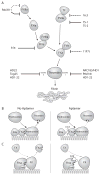Modulation of the Coagulation Cascade Using Aptamers
- PMID: 26315404
- PMCID: PMC5304947
- DOI: 10.1161/ATVBAHA.115.300131
Modulation of the Coagulation Cascade Using Aptamers
Abstract
As a novel class of therapeutics, aptamers, or nucleic acid ligands, have garnered clinical interest because of the ease of isolating a highly specific aptamer against a wide range of targets, their chemical flexibility and synthesis, and their inherent ability to have their function reversed. The following review details the development and molecular mechanisms of aptamers targeting specific proteases in the coagulation cascade. The ability of these anticoagulant aptamers to bind to and inhibit exosite function rather than binding within the active site highlights the importance of exosites in blocking protein function. As both exosite inhibitors and reversible agents, the use of aptamers is a promising strategy for future therapeutics.
Keywords: anticoagulation; aptamer; coagulation cascade; nucleic acids; serine endopeptidases.
© 2015 American Heart Association, Inc.
Figures

References
-
- Ellington AD, Szostak JW. In vitro selection of rna molecules that bind specific ligands. Nature. 1990;346:818–822. - PubMed
-
- Gold L, Polisky B, Uhlenbeck O, Yarus M. Diversity of oligonucleotide functions. Annual review of biochemistry. 1995;64:763–797. - PubMed
-
- Tuerk C, Gold L. Systematic evolution of ligands by exponential enrichment: Rna ligands to bacteriophage t4 DNA polymerase. Science. 1990;249:505–510. - PubMed
-
- Nimjee SM, Rusconi CP, Harrington RA, Sullenger BA. The potential of aptamers as anticoagulants. Trends Cardiovasc Med. 2005;15:41–45. - PubMed
Publication types
MeSH terms
Substances
Grants and funding
LinkOut - more resources
Full Text Sources
Other Literature Sources
Research Materials

